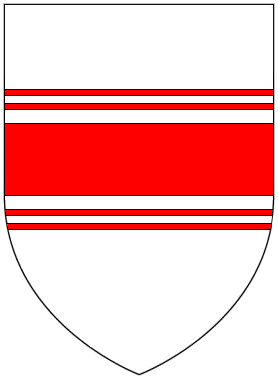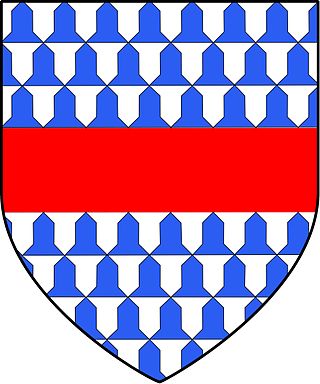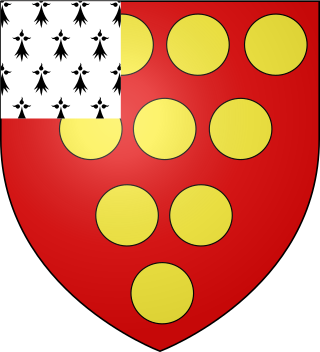The title of Baron Grey of Codnor is a title in the peerage of England.

Baron Willoughby de Eresby is a title in the Peerage of England. It was created in 1313 for Robert de Willoughby. Since 1983, the title has been held by Jane Heathcote-Drummond-Willoughby, 28th Baroness Willoughby de Eresby.

Baron Greystoke is a title that has been created twice in the Peerage of England. It was first created when John de Greystok was summoned to Parliament in 1295.

John Beaumont, 4th Baron Beaumont KG (1361–1396) was an English military commander and Admiral who served in the Hundred Years' War against the partisans of Antipope Clement VII.

Edmund Mortimer, 2nd Baron Mortimer of Wigmore was the second son and eventual heir of Roger Mortimer, 1st Baron Mortimer of Wigmore. His mother was Maud de Braose.

Alan la Zouche, 1st Baron la Zouche of Ashby was born at North Molton, Devonshire, the only son of Roger La Zouche and his wife, Ela Longespée, daughter of Stephen Longespée and Emmeline de Ridelsford. He received seisin of his father's lands after paying homage to the king on 13 October 1289. Alan was governor of Rockingham Castle and steward of Rockingham Forest. Alan La Zouche died without any sons shortly before at the age of 46, and his barony fell into abeyance among his daughters.
Maurice FitzThomas FitzGerald, 4th Earl of Kildare was a prominent Irish nobleman in the Peerage of Ireland who held the office of Lord Justice of Ireland.

Giles de Badlesmere, 2nd Baron Badlesmere was an English nobleman.
The Record Commissions were a series of six Royal Commissions of Great Britain and the United Kingdom which sat between 1800 and 1837 to inquire into the custody and public accessibility of the state archives. The Commissioners' work paved the way for the establishment of the Public Record Office in 1838. The Commissioners were also responsible for publishing various historical records, including the Statutes of the Realm to 1714 and the Acts of Parliament of Scotland to 1707, as well as a number of important medieval records.

There have been four different baronies held by the Marmion family, two feudal baronies, one purported barony created by Simon de Montfort and one barony by writ.
Philip Marmion, 5th and last Baron Marmion of Tamworth was King's Champion and Sheriff. He was descended from the lords of Fontenay-le-Marmion in Normandy, who are said to have been hereditary champions of the Dukes of Normandy.

David Flitwick, of Flitwick, Bedfordshire, was an English politician and soldier of the Anglo-Scots Wars.

David Flitwick (1281–1353), of Flitwick, Bedfordshire, was an English politician and soldier of the Anglo-Scots Wars who followed in the footsteps of his grandfather, also David Flitwick.

Robert Marmion was an Anglo-Norman nobleman and rebel involved in the First Barons' War. He was referred to as "Robert Marmion the Younger" as his elder half-brother was also called Robert and known as "Robert Marmion the Elder".
John Marmion, Baron Marmion of Winteringham was an Anglo-Norman baron who represented Lincolnshire in Parliament and fought in the Wars of Scottish Independence.
Sir John Marmion, Baron Marmion of Winteringham was an Anglo-Norman baron who represented Lincolnshire in Parliament and fought in the Wars of Scottish Independence.

William la Zouche, 1st Baron Zouche (1276/86–1352), lord of the manor of Harringworth in Northamptonshire, was an English baron and soldier who fought in the Wars of Scottish Independence. He is referred to in history as "of Harringworth" to distinguish him from his first cousin Alan la Zouche, 1st Baron la Zouche (1267–1314) of Ashby de la Zouch in Leicestershire.

Sir Adam de Everingham, 2nd Baron Everingham, Lord of Laxton, was an English noble who fought during the Second War of Scottish Independence and the Hundred Years' War.

Sir Adam de Everingham, 1st Baron Everingham, Lord of Laxton, was an English noble.

Sir Robert de Ogle was an English soldier and feudal landowner in Northumbria who fought in the border conflicts with Scotland. He captured five Scottish knights near Newcastle in 1341 and was licensed to crenellate Ogle House. He distinguished himself in resisting the foray into Cumberland of Sir William Douglas in 1345, fought at Neville's Cross in 1346 and took three nobles prisoner, and held Berwick Castle against the Scots in 1355.











